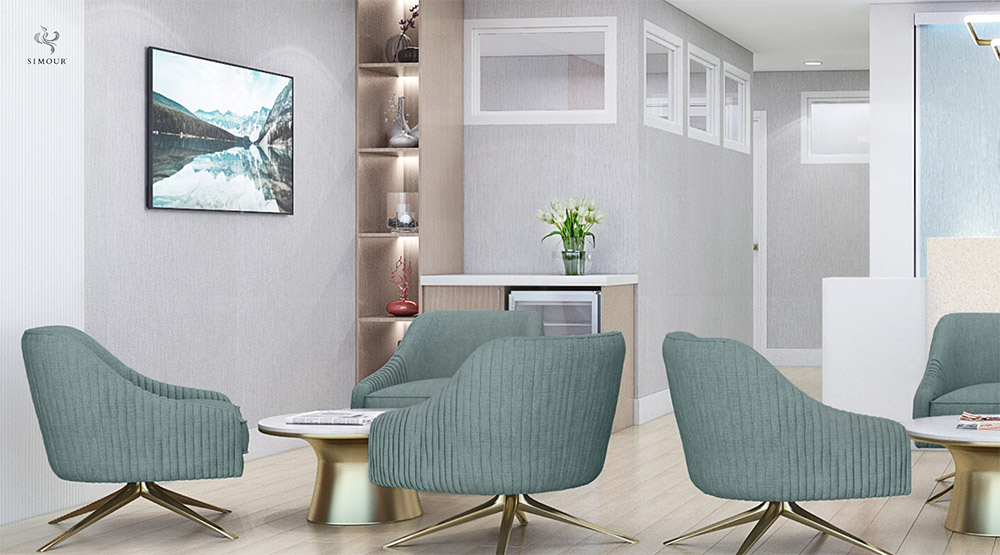“Great things in business are never done by one person. They’re done by a team of people.” – Steve Jobs
Medical interior design can help create an environment that is conducive to the work of medical professionals, providing them with a space that is comfortable, efficient, and effective.
By considering the needs of your team and patients alike, interior design can help transform your office to a space that encourages productivity and collaboration. How can interior design improve team productivity? Read more below.
1. Increased safety
Medical interior design can help improve safety for both patients and medical staff. Designing spaces with proper lighting, clear signage, and easy-to-navigate layouts can reduce the risk of accidents, while the proper placement of equipment and supplies can help minimize the risk of infections, healthcare-associated infections (HAIs), and other safety hazards.
2. Improved patient experience
A well-designed medical interior can contribute to a positive patient experience, which can ultimately improve team productivity. Patients who are more comfortable and at ease, are likely to be more compliant with treatment plans leading to better health outcomes. By creating spaces that are designed for patient comfort and safety, healthcare professionals can provide better care and improve patient satisfaction. This can lead to better outcomes, reduced readmissions, and an improved reputation for the healthcare facility.
3. Increased efficiency
A well-designed medical interior can improve the workflow and efficiency of medical teams. By creating spaces that are easy to navigate, have clear pathways, and are organized with all necessary equipment and supplies, teams can work more efficiently, reducing the time they spend on non-patient-related tasks and allowing them to focus more on patient care.
4. Enhanced communication
Medical interior design can help to facilitate better communication between healthcare professionals, patients, and their families. For instance, open spaces and strategically placed furniture can promote collaboration and teamwork, leading to better outcomes. Enhanced communication: Medical interior design can facilitate better communication among healthcare teams. By creating spaces that are designed for collaboration and communication, such as open workspaces or team meeting rooms, healthcare professionals can work together more effectively to provide better patient care. The use of technology, such as teleconferencing systems, can enable remote collaboration and communication.
5. Reduced stress
Healthcare professionals often work in high-stress environments. Well-designed medical interiors can help to create a calm and relaxing environment that can reduce stress levels and promote mental wellness among the staff. Medical interior design can help reduce stress by providing dedicated spaces that are calming and restorative, such as relaxation rooms or outdoor spaces. This can help healthcare workers recharge and feel more energized, leading to increased productivity.
6. Improved ergonomics
By designing spaces that are ergonomically sound and easy to use, medical interior design can reduce physical strain on healthcare professionals. This can lead to fewer injuries and less fatigue, allowing healthcare workers to work more efficiently and effectively. Using ergonomic chairs for example provides the support needed especially for prolonged periods of seating like those for receptionists. Designing the workplace too so that access will not need ladders allows staff to grab hold of things within arm’s reach.
7. Improved Staff Satisfaction
Medical interior design can also contribute to the job satisfaction of medical staff. By designing spaces that are comfortable, aesthetically pleasing, and well-organized, staff members can feel more positive about their work environment, which can improve their morale and motivation.
Overall, medical interior design can help to create a more functional, safe, and pleasant working environment for healthcare professionals. By improving staff well-being, reducing stress levels, and enhancing communication and collaboration, medical interior design can promote team productivity and ultimately lead to better patient outcomes. We urge you to put the focus on your team too when making these improvements to your own medical interiors. A better workplace can influence the quality of care that you aspire to deliver.
Let our intentional design process elevate your practice and team productivity by booking a complimentary consultation today. We’d love to hear from you soon!




